The Sleepy Georgian Home of London Antiques Dealer Will Fisher
Posted by admin on
London antiques dealer Will Fisher attributes his interest in interiors to a childhood encounter with a character named Warner Dailey, the father of his best friend. Fisher’s favorite saying—and a tenet he continues to live by—comes from Dailey: “I’m interested in things that look like they’ve grown roots on them.”
Photography by Simon Upton.
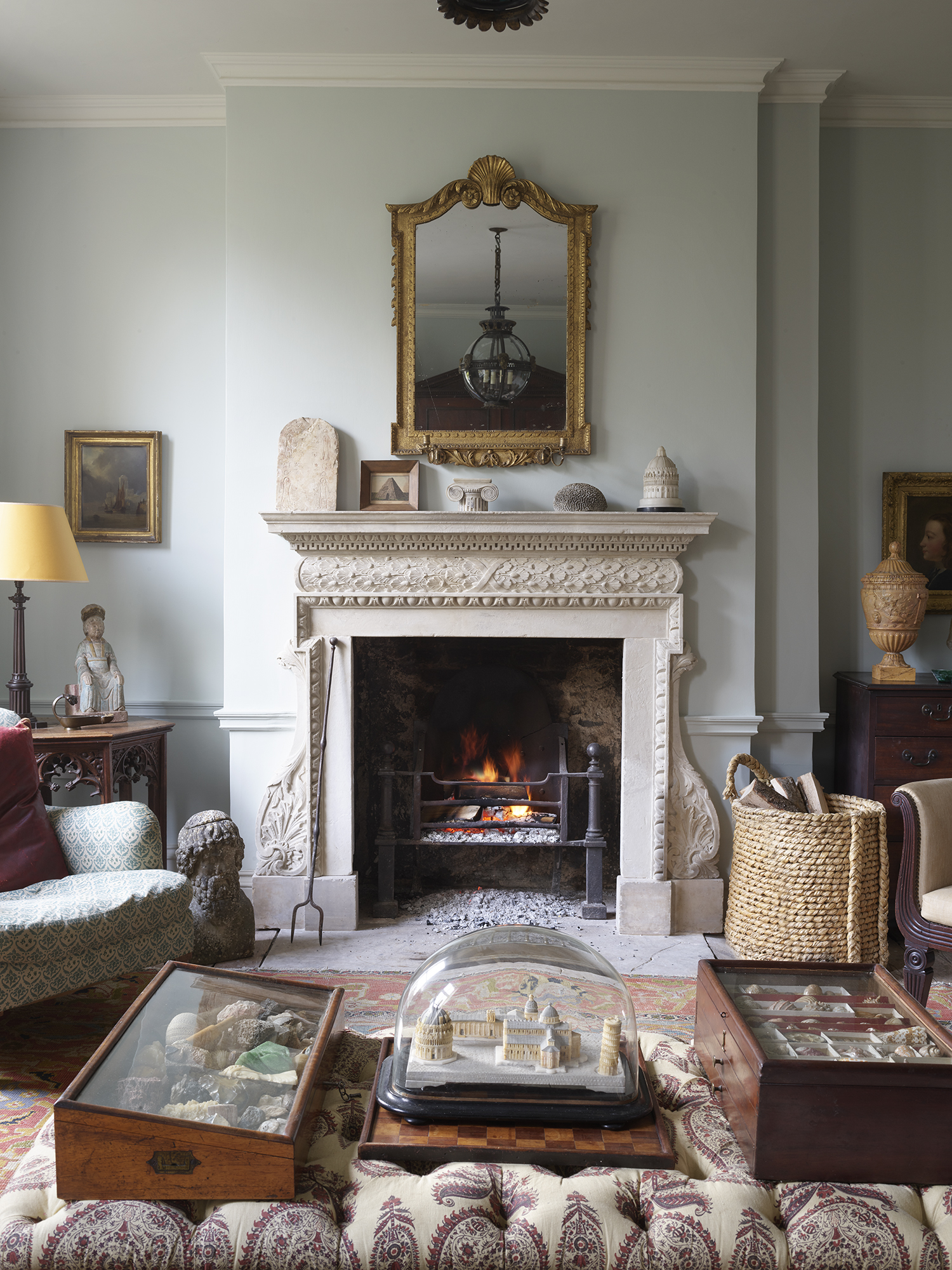 Above: The drawing room of Jamb founders Will Fisher and Charlotte Freemantle.
Above: The drawing room of Jamb founders Will Fisher and Charlotte Freemantle.
Jamb, the company Fisher runs with his wife, Charlotte Freemantle, has gained an international reputation for sourcing and reproducing such objects: rare fireplace mantels, 18th-century statuary, exquisite reproduction lighting, and country house furniture. Their gallery on the Pimlico Road in London’s Belgravia is frequented by celebrities and royalty, but Fisher is more likely to be found in their workshop in the lesser-known suburb of Mitcham. “It has become the throbbing heart of the company,” he says. “I find it utterly intoxicating to be in that environment, putting things together, working out how we can take objects and make them more appealing, more beautiful, more perfect in any way.”
Quality and surface are the two defining factors Fisher looks for and seeks to recreate: “We try and buy things that have avoided human intervention from the moment of their creation. That is very much a theme throughout our business and throughout our home.”
The couple live in a four-story Georgian terrace in Camberwell, south London. When they purchased the property in 2006, it was viewed as “the ugly duckling” of the street. (A Gothic Revival bay window and porch had been added to the purist Georgian facade.) But the couple both felt “unbelievably excited” by the interiors, which, although in “a state of decay” and stripped of original features, had managed to retain “a lot of soul.”
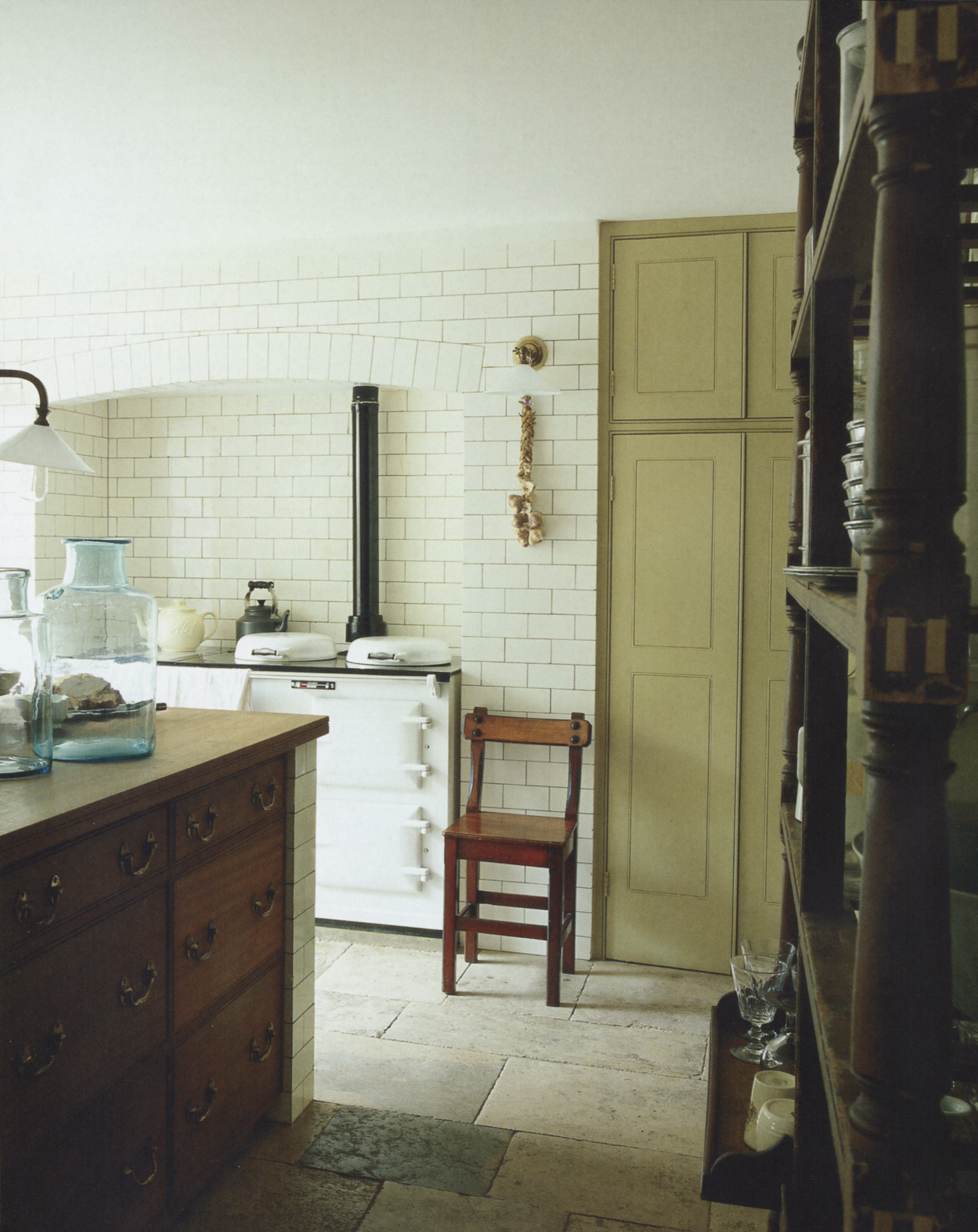 Above: The reclaimed wall tiles are from the Manhattan subway. The bespoke kitchen island is made from reclaimed teak laboratory tops; the heavy brass handles were salvaged from an old plan chest. The built-in cupboard has a concealed bead panel—”the purest of simple decoration”—and is painted in Biscuit, an archive Farrow and Ball color that Fisher describes as “country house livery.”
Above: The reclaimed wall tiles are from the Manhattan subway. The bespoke kitchen island is made from reclaimed teak laboratory tops; the heavy brass handles were salvaged from an old plan chest. The built-in cupboard has a concealed bead panel—”the purest of simple decoration”—and is painted in Biscuit, an archive Farrow and Ball color that Fisher describes as “country house livery.”
Fisher set about sourcing new-but-old surfaces, starting in the basement kitchen and working his way up through the four storys. He found a quantity of fossil-rich Purbeck stone, which he stored in a barn for several months, hand-selecting the slabs and having each piece individually milled before laying it throughout the basement level. “It looks enormously probable,” he says. “I don’t think anyone would ever come in the house and not think that the floor has always been there.”
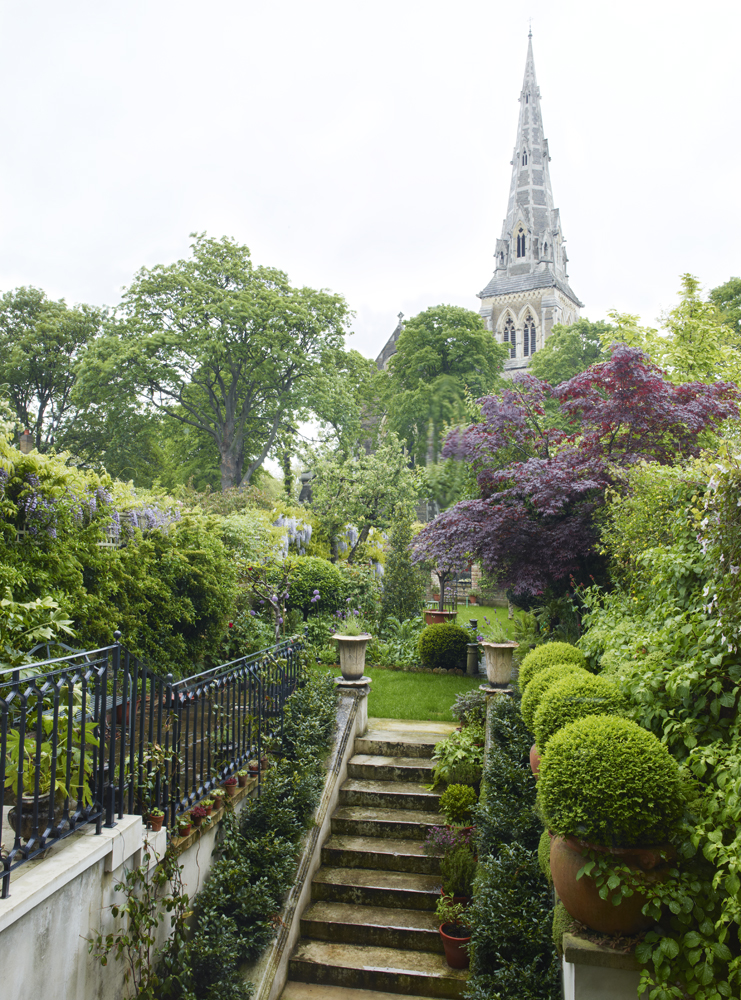 Above: Fisher installed an 18th-century flight of stone stairs connecting the basement kitchen to the raised garden beyond (which readers may recognize from the front cover of our Gardenista book). An enlarged door allows more light into the basement and makes a focal point of St Giles’ steeple beyond.
Above: Fisher installed an 18th-century flight of stone stairs connecting the basement kitchen to the raised garden beyond (which readers may recognize from the front cover of our Gardenista book). An enlarged door allows more light into the basement and makes a focal point of St Giles’ steeple beyond.
The couple made the “emotionally and financially exhausting” decision to rebuild the interior walls with lathe and plaster. “It’s one of the most sympathetic things you can do to an old building—to allow it to breathe,” explains Fisher. “And it gives a fabulous feel to the entire house. When you look at the way the light hits the lime plaster, it is very, very different to the flat plane of a plastered wall. And light is everything, isn’t it? It really does set the tone for the entire house.”
Moving up through each story, they have adhered to what would have been the original hierarchy of the house. The kitchen retains the below stairs aesthetic of scrubbable surfaces and heavy, pared-back furniture. Then, as you ascend the stairs, the detailing on the doors and fireplaces becomes grander before quietening down again in the attic rooms. “Hopefully, it all kind of works and feels probable but still very sleepy,” says Fisher.
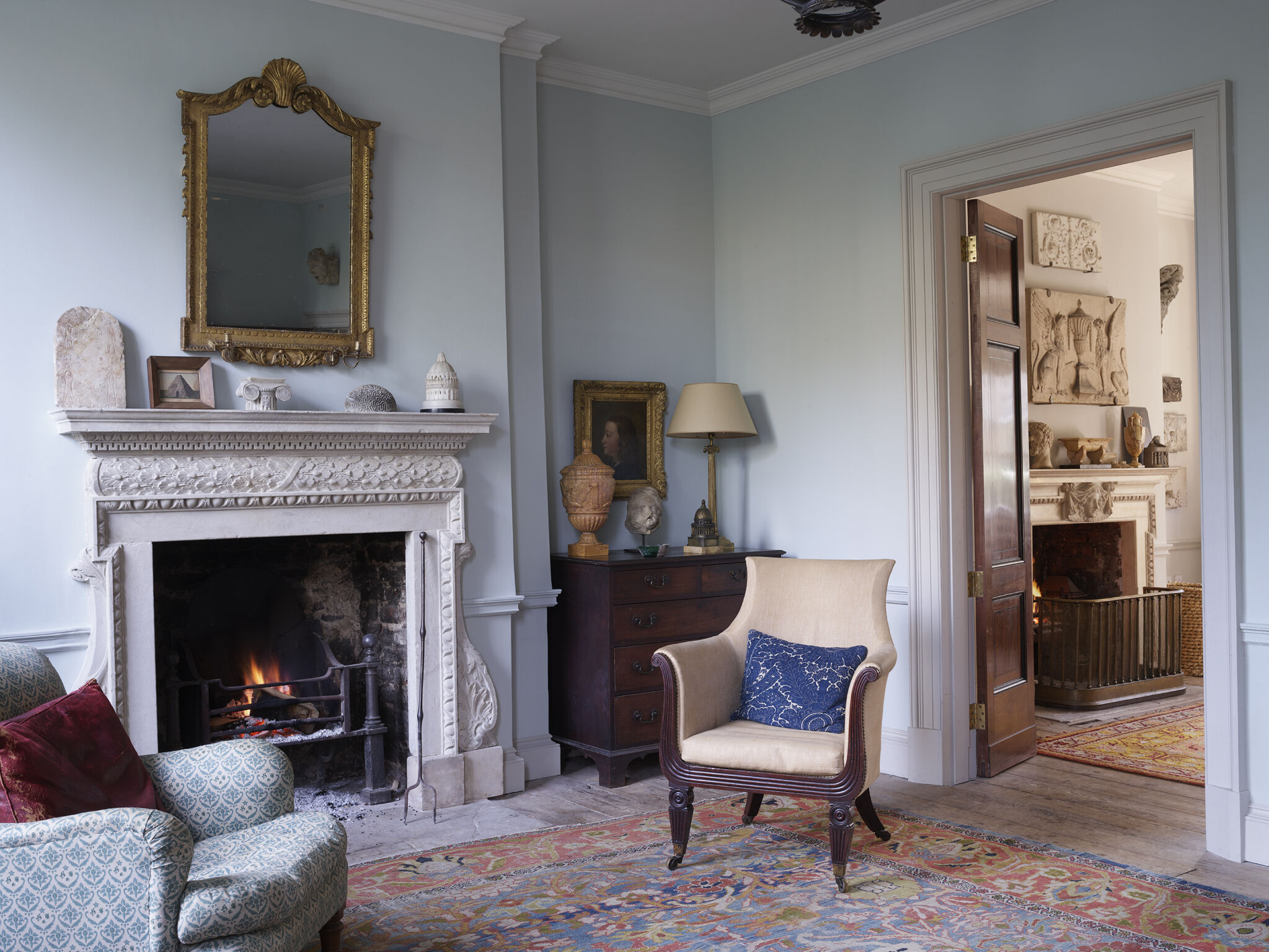 Above: In the drawing room, the couple have replaced their marble mantel with a stone mantle from 1740. “It was Charlotte’s idea,” says Fisher. “We bought this thing and kept looking at it saying: ‘God, imagine living with that.’ Eventually we thought: ‘Well, why not actually live with it?’”
Above: In the drawing room, the couple have replaced their marble mantel with a stone mantle from 1740. “It was Charlotte’s idea,” says Fisher. “We bought this thing and kept looking at it saying: ‘God, imagine living with that.’ Eventually we thought: ‘Well, why not actually live with it?’”
Their quintessentially British front room was redecorated during lockdown. “If you can’t change your location, change your environment,” reasoned Fisher. “We literally got above our station and went wildly over the top in a sort of English Palladian country house way,” he recalls. “We almost put on our powdered wigs—it was really fun.” The new mantle preempted a change of color, too. The walls went from pale slate to “the ultimate duck-egg blue.”
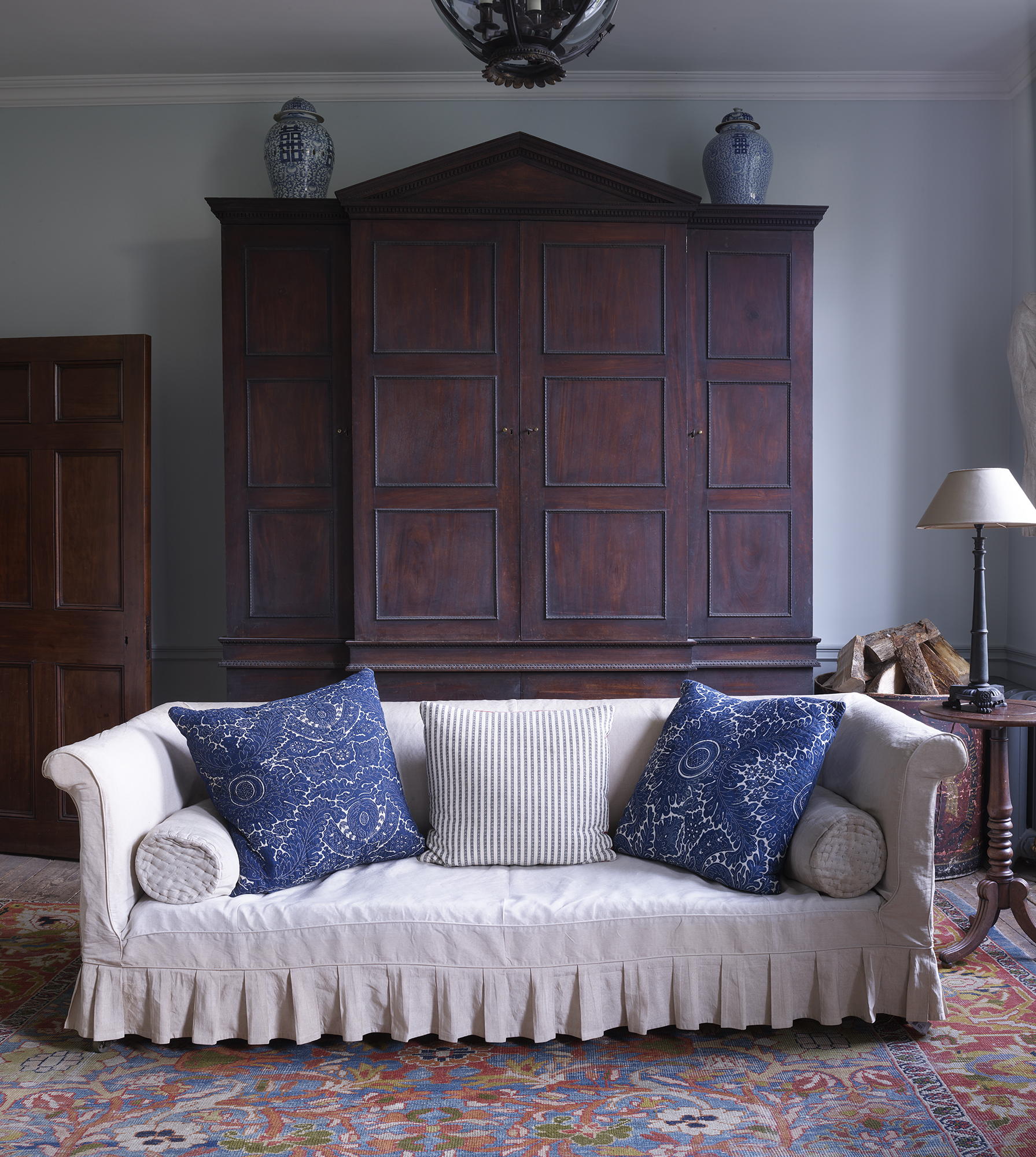 Above: Behind the sofa (an antique they are reproducing for their own range of settees), Fisher installed a vast cabinet that he describes as “the holy grail of country house surfaces—a pure, architectural cabinet that is comparable to a perfect Palladian building placed at the back of our drawing room. Sadly, it’s something of such significant value that one day, we’ll have to let it go through our hands.”
Above: Behind the sofa (an antique they are reproducing for their own range of settees), Fisher installed a vast cabinet that he describes as “the holy grail of country house surfaces—a pure, architectural cabinet that is comparable to a perfect Palladian building placed at the back of our drawing room. Sadly, it’s something of such significant value that one day, we’ll have to let it go through our hands.”
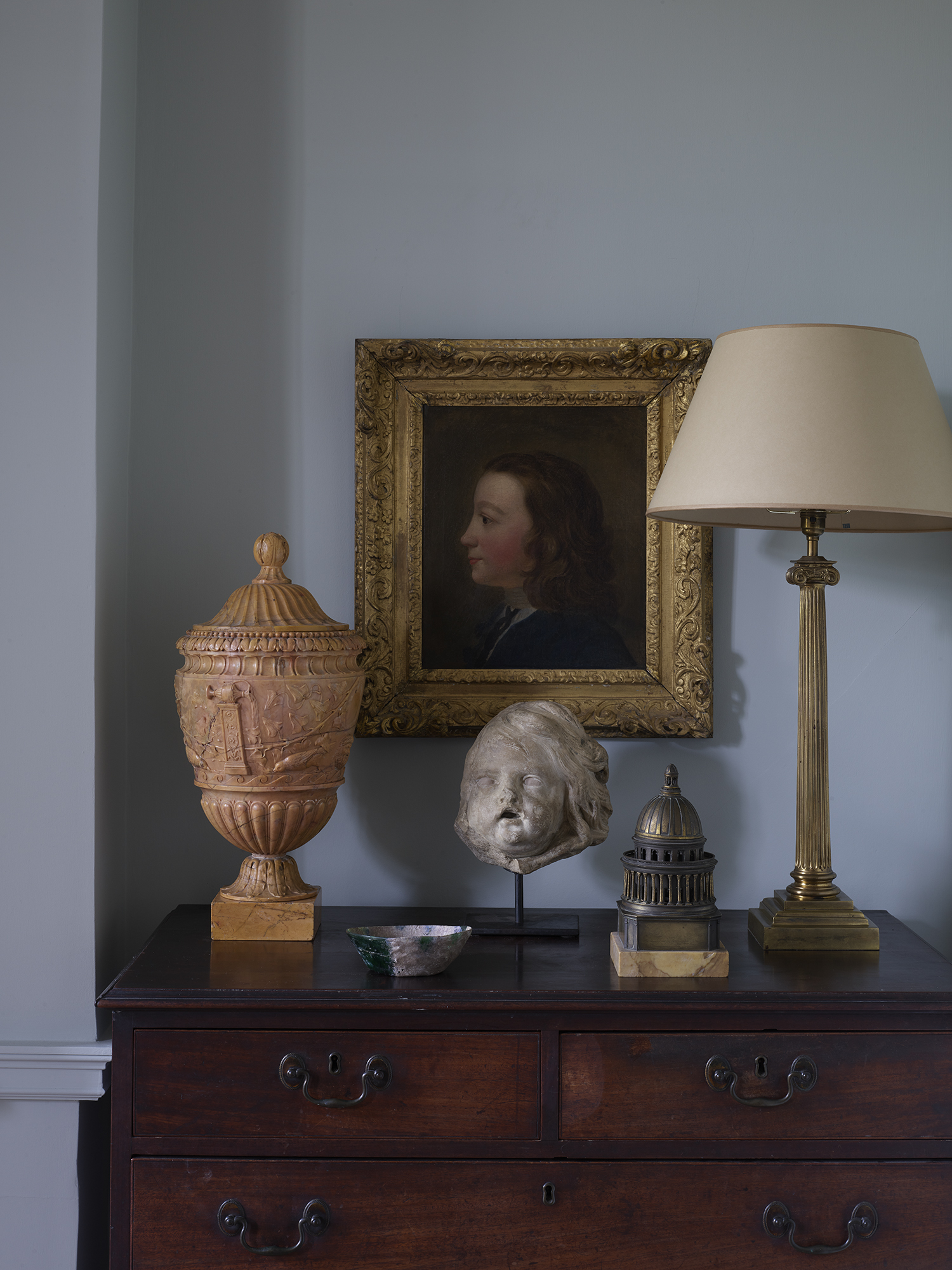 Above: A detail from the drawing room.
Above: A detail from the drawing room.
The drawing room is connected via double doors to the “tablet room.” (“That sounds slightly grandiose,” says Fisher. “It’s actually our TV room.”) Here, the walls are adorned with fragments of central tablets from chimney pieces. “It’s extraordinary how objects form so much of our identity,” says Fisher.“ After a hard day’s work, there’s something incredibly soothing about coming home and being surrounded by the things you love. I don’t think a day goes by that we don’t gain pleasure from the objects in this room.”
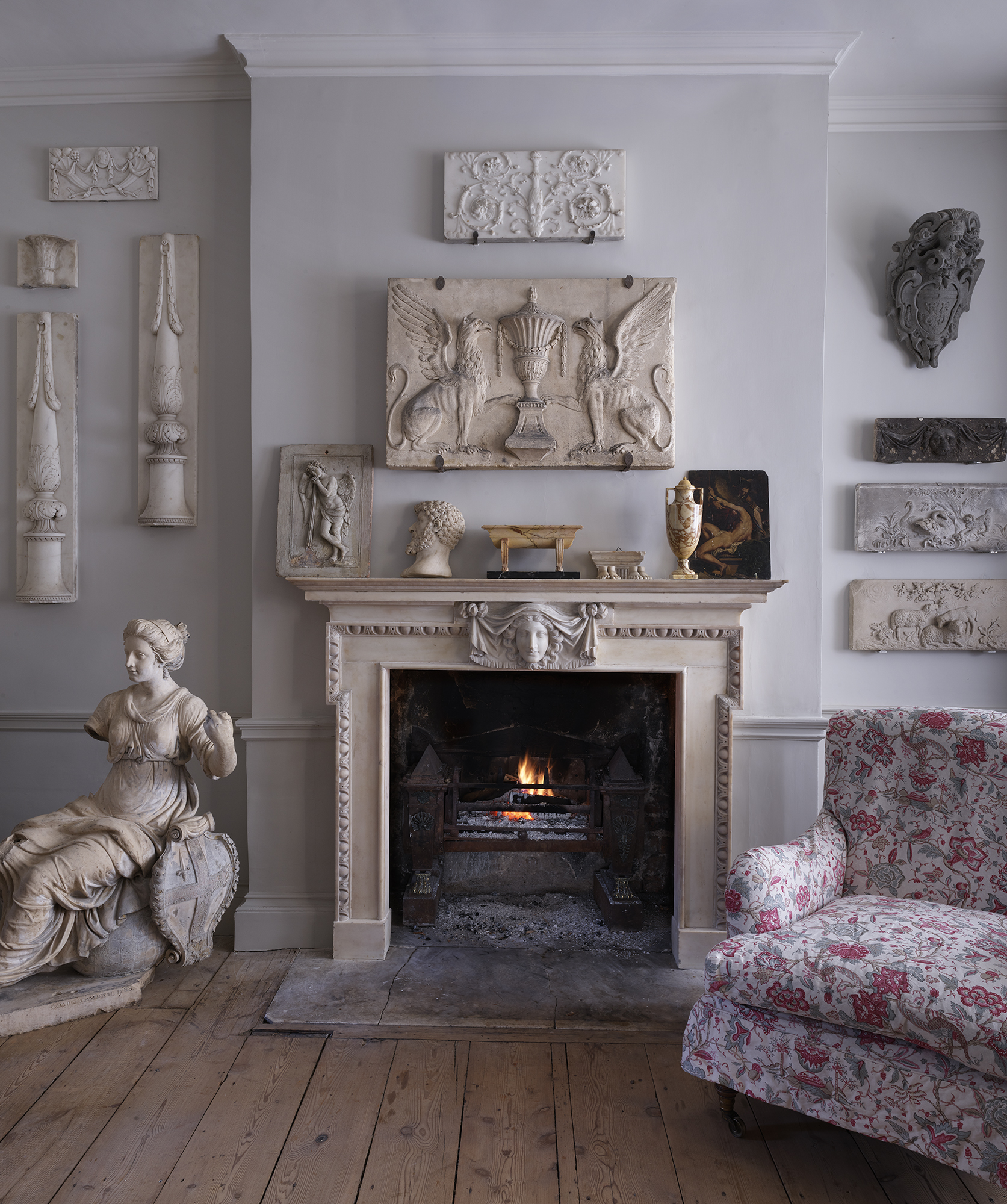 Above: A statue of Britannica from 1786 rests beside the fire. “Again, it’s one of those things that brings us both enormous joy,” says Fisher. “She would have originally been ornamentation on a building, but we brought her inside. I like reinventing external objects. I think, after years of being subjected to the elements, they deserve a bit of respite.”
Above: A statue of Britannica from 1786 rests beside the fire. “Again, it’s one of those things that brings us both enormous joy,” says Fisher. “She would have originally been ornamentation on a building, but we brought her inside. I like reinventing external objects. I think, after years of being subjected to the elements, they deserve a bit of respite.”
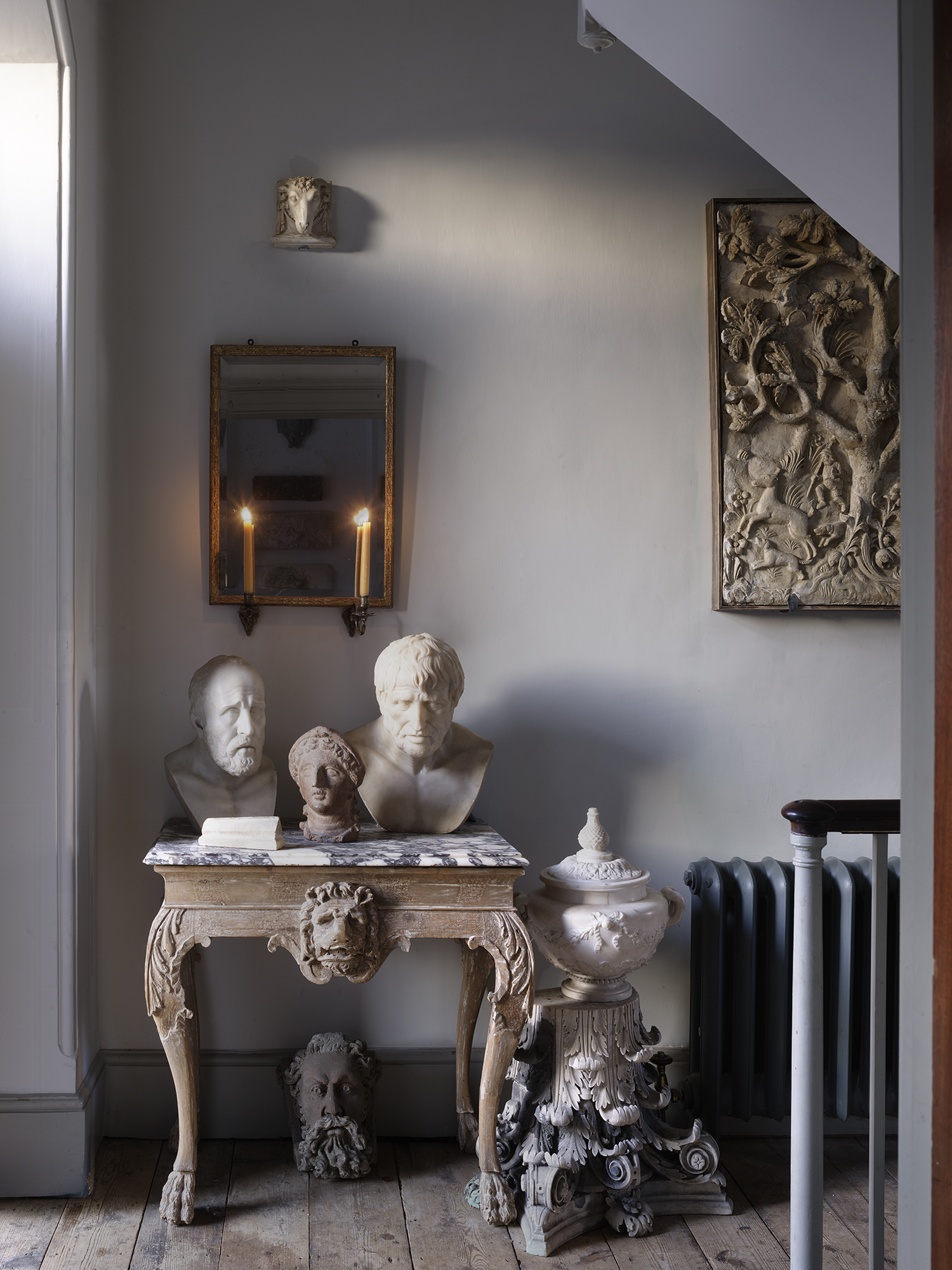 Above: A scene from the hallway includes an upturned capital and 18th-century vase and a collection of busts, including the Greek Stoic philosopher, Chrysippus (far left).
Above: A scene from the hallway includes an upturned capital and 18th-century vase and a collection of busts, including the Greek Stoic philosopher, Chrysippus (far left).
“Many objects have emotional attachment—not just for what they are, but for the circumstances in which they were procured,” says Fisher. The bust of Chrysippus was bought from an online auction while Fisher was in hospital with his son, Monty, then age three. “I have a rule that I don’t buy anything unless I—or somebody I trust implicitly—have seen it. But obviously the fact that we were in the hospital meant I had to take a leap of faith. The bust is very much a remembrance of that time. It also sort of encompasses Monty’s stoic behavior at that time.”
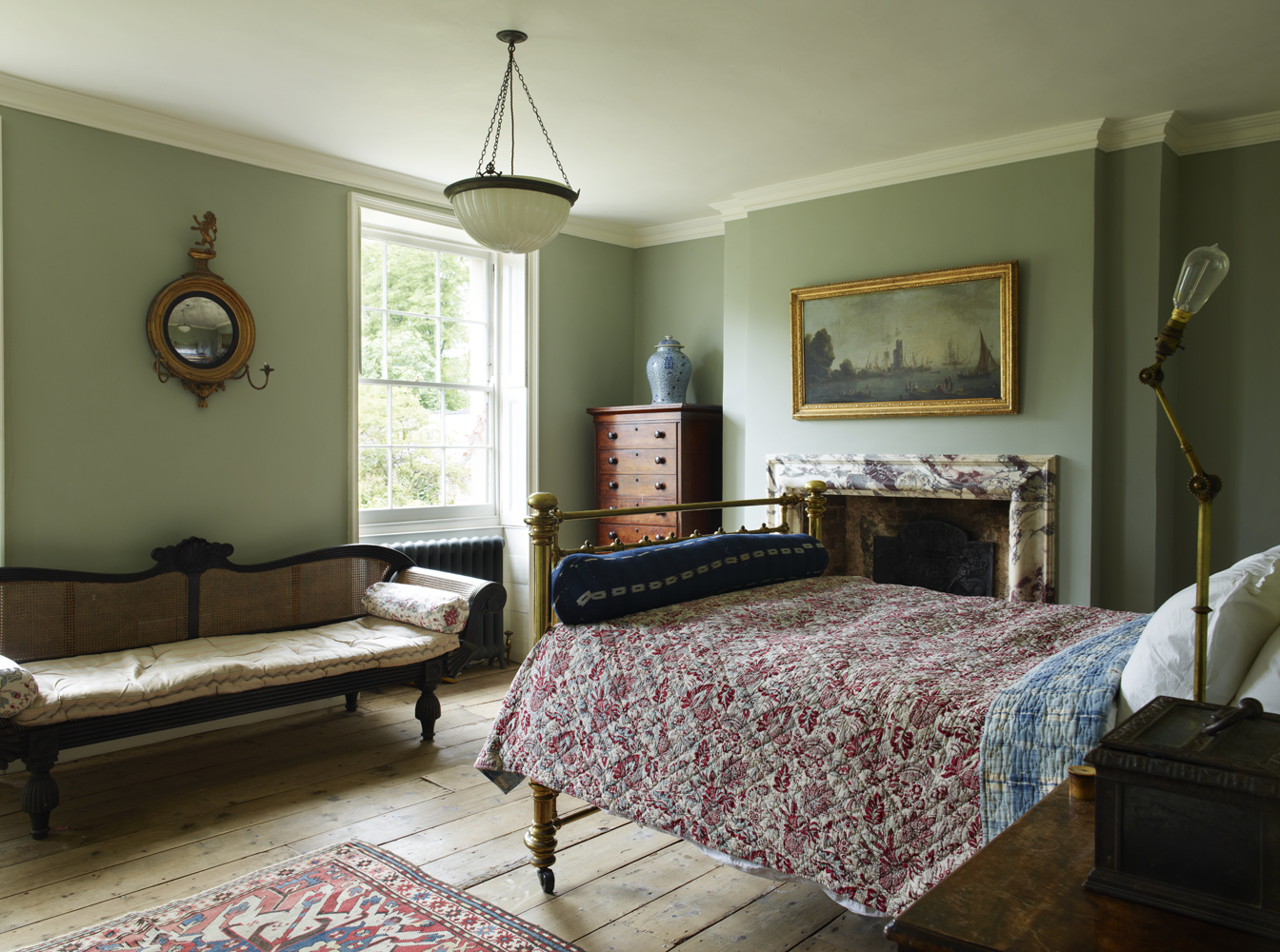 Above: The Blue Gray main bedroom features an antique gilt lacquer brass bed (“as rare as hen’s teeth,” says Fisher) covered in fabrics from Katharine Pole, a Ceylonese ebony sofa (“the least practical bit of furniture in the world, but the most adorable”), and a gilt crested mirror from 1820. The bedside lamp is an antique from Jamb’s sister company, Hawker Antiques.
Above: The Blue Gray main bedroom features an antique gilt lacquer brass bed (“as rare as hen’s teeth,” says Fisher) covered in fabrics from Katharine Pole, a Ceylonese ebony sofa (“the least practical bit of furniture in the world, but the most adorable”), and a gilt crested mirror from 1820. The bedside lamp is an antique from Jamb’s sister company, Hawker Antiques.
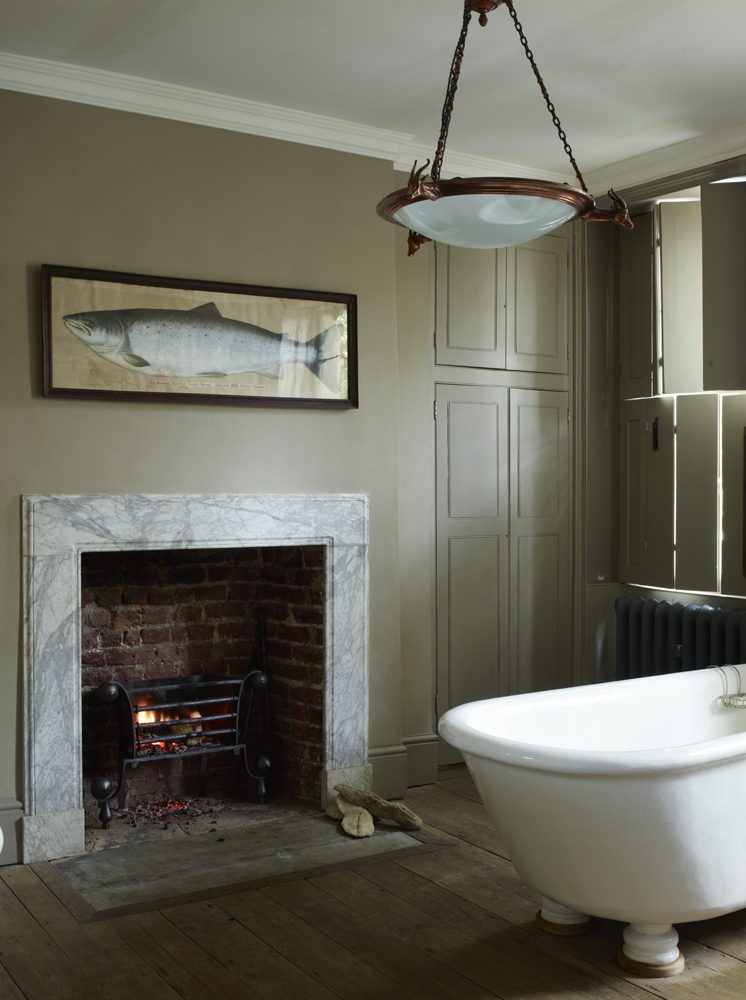 Above: An open hearth in the family bathroom. As in the kitchen, the built-in cupboard features “effortlessly beautiful” concealed bead panelling.
Above: An open hearth in the family bathroom. As in the kitchen, the built-in cupboard features “effortlessly beautiful” concealed bead panelling.
“There is a fundamental framework that we adhere to within the business and at home,” reflects Fisher. “Some of the things that enter the premises are planned, some aren’t. We’re never looking for something for a specific location: we’re more likely to find a specific item, and then find a location for it.” That said, the couple have over the years, sold off many of their personal possessions. The contents of their tablet room were auctioned off in 2012 (“we were both bereft”) and they have found themselves sofa-less on more than one occasion. “I don’t know why we ended up selling the sofas,” says Fisher. “It’s one of those ridiculous things, the temptation of an antique dealer. We’re fundamentally hawkers and traders. Also, we need something to sulk about. Life’s nothing without regret.
For more characterful English interiors, see:
An Eccentric Town House in Islington by Design Star Rachel Chudley
